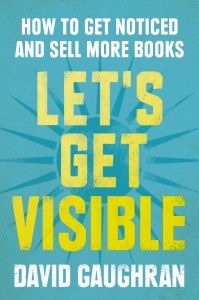This book had me diving into my current e-book projects within the first few minutes of opening the review copy, looking at how to improve the preview, feedback hooks, tagging, category choice, etc. And by the end, I had a whole checklist of sites to visit, tweaks to make, programs to sign up for. That’s how useful it is.
Irish author and self-publishing proselyte David Gaughran has turned himself into quite an advocate for the e-publishing revolution. Advocate is putting it mildly; I wouldn’t like to be the publisher or vanity press on the receiving end of a diatribe like this. His earlier guide, Let’s Get Digital: How To Self-Publish, And Why You Should, dealt with the production and distribution side.

Let’s Get Visible, meanwhile, is more about the marketing side—or rather, how to get off the endless treadmill of futile self-promotional exercises that so many e-authors seem to condemn themselves to these days without discernible benefit. Here he will tell you how to strategize a book launch, how to up sales with a free or discount promotion, how to market on or outside Amazon, etc., etc., all with the benefit of the latest direct input from Amazon and other e-retailers.
That said, this is a book with limitations. The visibility it talks about is strictly and narrowly visibility on Amazon and other e-book publishing platforms. As Gaughran says, it “will do two things. It will break down Amazon’s famous recommendation engine and detail the various opportunities for exposure on Amazon’s sites. Plus, it will give you practical help on how to implement this knowledge.”
Other platforms, such as Nook or Kobo, get shorter shrift, and 100 percent self-published authors even less, although, he stresses, “self-publishers don’t tend to do as well outside of Amazon, except in certain genres.” And despite the subtitle, the book will not tell you how to get noticed in print media, on TV, in review columns or in bookshops. It will not tell you about reading events, press releases, interviews and building your Facebook fan base. It will, though, definitely help you sell more books.
As it happens, I agree with Gaughran’s emphasis on Amazon. For a self-publishing author, this is still the best way to go to secure the whole package of bootstrapped marketing exposure, distribution and security; and unless you lock in to KDP Select, you can always pursue the other channels as well. (If you have ideological objections to the Amazon colossus, meanwhile, that’s your business.)
Gaughran is clear-eyed and unsentimental about Amazon, but as he outlines it, the Amazon ecosystem, however self-serving, offers exposure mechanisms and drivers that ultimately benefit authors “in a kind of convoluted meritocracy;” on other platforms, exposure is “either parceled up and sold off to large publishers or hand-picked books chosen by merchandizing teams.” Plus, much of the straight common-sense advice here, such as putting a link or email address in the text to build your reader mailing list, should work for everyone, even print authors.
Gaughran never pretends that good marketing can substitute for good writing–his guide is offered to free up writers’ time to focus on the writing. “I will urge you to cut back on time-heavy promotional activity and substitute it with something altogether more powerful,” he states. For almost any author with a chance of getting a sale in the first place, this book will surely justify its purchase price by snagging you enough readers to cover its cost—unless and until Amazon radically changes its policies. So go on—what have you got to lose?
* * *
About the Reviewer: Paul StJohn Mackintosh’s own first poetry collection, The Golden Age, which uses some of the techniques mentioned in this book, is available on Kindle here.
































